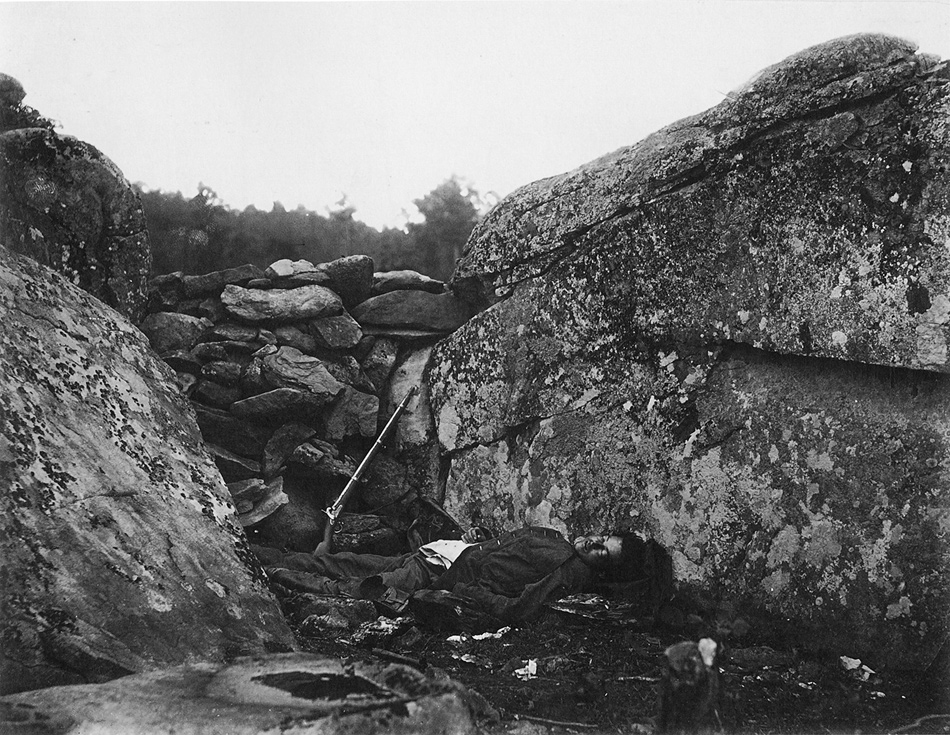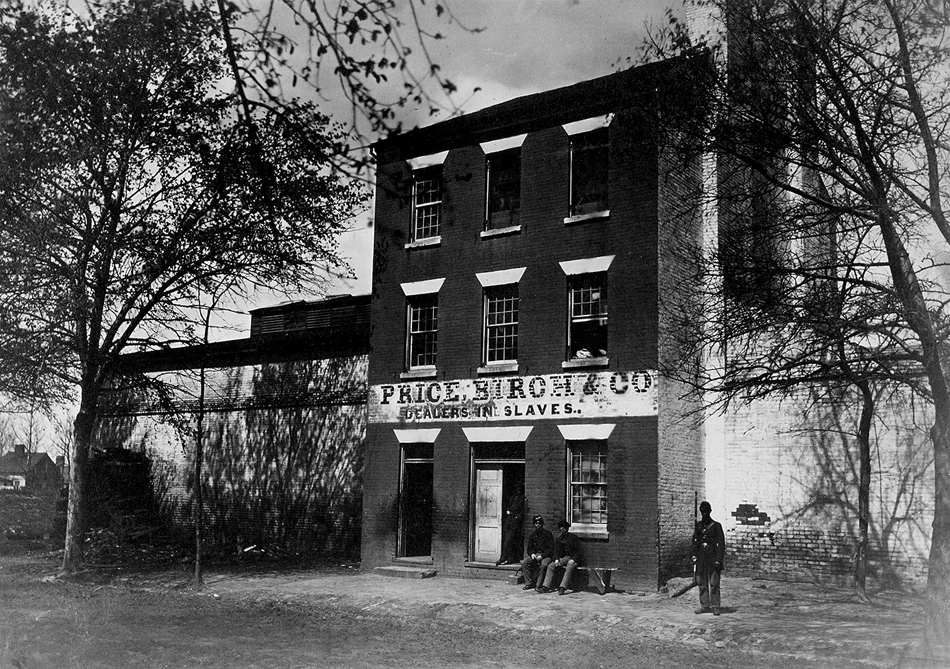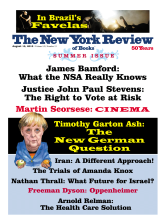
Metropolitan Museum of Art
Alexander Gardner: The President [Abraham Lincoln], Major General John A. McClernand [right], and E.J. Allen [Allan Pinkerton, left], Chief of the Secret Service of the United States, at Secret Service Department, Headquarters Army of the Potomac, Near Antietam, October 4, 1862
Photography began as a craft technology that lent its resources to the imitation of an art—chiefly, at first, portrait and landscape painting—and like other devices of convenience, it easily adopted the name of its inventor. We no more associate the daguerreotype with a particular French painter than we connect the guillotine to a particular doctor, and this marks an initial difference from the high arts: it would be odd to imagine anyone ever talking of the poussinline or a rubensstroke without a vivid and characteristic idea of the discoverer himself. Photography was a tool like the telephone or the automobile; not, like the symphony or the twelve-tone system, an unmistakably aesthetic format. You looked at a photograph, if you were looking in the 1860s, with an eye trained by the conventional expectations of pictorial realism.
The claim of the new art was that it offered the most accurate rendering of a person, place, or thing. Also the most accessible: as Jeff L. Rosenheim tells us in Photography and the American Civil War—his splendid catalog of the exhibition on view at the Metropolitan Museum of Art—more than 25 million daguerreotypes had been produced in the United States by 1860. So Mathew Brady could rely on a seasoned audience when he took his photograph of Abraham Lincoln on February 27, 1860, dressed for the Cooper Union speech, where he would affirm the Republican Party’s stand against the expansion of slavery, and declare his faith that right makes might. “The tones,” wrote Noah Brooks in the Chicago Tribune of that evening’s performance, “the gestures, the kindling eye, and the mirth-provoking look defy the reporter’s skill.” None of those traits could have been plausibly inferred from Brady’s portrait; but there is a recessive strength in the eyes and a natural (not assumed) gravity of bearing that pay a compliment to the model. The picture served Lincoln well.
But the length of standing-still required for the exposure was never a pleasant exertion for him. In early October 1862, Brady sent one of his photographers, Alexander Gardner, to take a series of pictures at General George McClellan’s headquarters at Antietam; and Lincoln, whose disgust at McClellan’s failure to move his troops into battle was by then an open secret, commented on the arrangements for the group portraits: “General McClellan and myself are to be photographed tomorrow A.M. by Mr. Gardner if we can be still long enough. I feel Gen. M. should have no problem on his end but I may sway in the breeze a bit.”
The most theatrical presence in these photographs, however, is not the haughty McClellan but the chief of the secret service Allan Pinkerton: his arm, in one ostentatious pose, crooked and resting inside the chest of his buttoned overcoat, where a pistol may or may not be concealed. Pinkerton, in this shot, leans forward with a look of fierce scrutiny and interrogative challenge: a detective from top to toe, you would say. Yet there is no more truth in photographs than there is in a glimpse of a passing face on the street. McClellan’s slowness may be legendary, but one cause of it was Pinkerton’s considerable overestimate of the size of the army of General Robert E. Lee; and his mistake was a result of inexperience and gullibility.
Such truth as photography may yield is often a result of inferring backward. We pass from things we have learned from other sources to the confirmation and the deepened knowledge that photography can afford. This is indeed a knowledge of character, circumstance, the springs of action and feeling, but that is not a kind of knowledge that any photograph carries within it. In the Civil War, photographs could be mined for evidence of a narrower sort: the actual condition of a weapon, for example, or the external appearance of a wound, or the state of disrepair of a bridge or a stretch of railroad. The camera was not yet fast enough for the work of registering and deciphering a large action composed of many smaller actions: the job that enlarged photographs or a series of views through a lens are asked to perform in movies like Blow-Up. Barred from some walks of ordinary truth by the limits imposed by the state of the art, photographers during the war did not hesitate to alter or transpose the data of a scene to achieve a higher ostensible truth.
Some of the most absorbing pages of the Met catalog recount the history of faked Civil War photographs. By a skillful rejiggering of person, place, and thing, and an appeal to stock emotions and predigested narratives, the most gifted of these artists worked up memorable false images that took on the irrefutable solemnity of settled fact.
Advertisement
Brady and Gardner (who left Brady’s workshop to start his own), along with George Barnard, in his photographs of Sherman’s march through Georgia, deliberately set up certain photographs with tricks to cheat the eye and a compositional forethought that amounts to dissimulation. Thus Brady, at Gettysburg, took an impressive two-negative panoramic photograph, Wheat-Field in Which General Reynolds Was Shot, an unpeopled landscape after the fact but a genuine picture as far as it went; and Gardner responded in his Photographic Sketch Book of the War with a pair of photographs by Timothy O’Sullivan: A Harvest of Death, Gettysburg and Field Where General Reynolds Fell, Gettysburg. The first of these came with an extended caption—“Killed in the frantic efforts to break the steady lines of an army of patriots,” and so on. But there is a hitch. The soldiers in the photograph, says Rosenheim, were “Union soldiers and Gardner likely knew so.”
Greater liberties were taken in a photograph composed and shot by Gardner himself, A Sharpshooter’s Last Sleep, Gettysburg. A glance at the picture reveals a rich opportunity, finely grasped: the fallen soldier splayed and supine against the mottled ground into which the body seems already decomposing. It happens that the rifle thrown beside him was a prop rifle that Gardner and O’Sullivan had used elsewhere—in itself a deception perhaps no worse than inserting a stock shot into a nature documentary, and as the judicious Rosenheim comments, “So far, so good.”
Yet Gardner saw further possibilities in the sharpshooter, and his team dragged the corpse seventy-two yards uphill “to a more intimate and visually attractive location,” meanwhile changing him from a Union soldier to a rebel. And so we find him a second time, in Home of a Rebel Sharpshooter, Gettysburg, his face availably tilted for the camera, sole resident of a fieldstone trench the exact shape of a coffin.
These fabrications should startle us only because they occur so early in the history of photography as a documentary art. But what else would we expect? Historical documents are shot through with lies—the pattern is as old as the human love of deception and the human appetite for stories. The difference between the genuine and the fraudulent photograph does not spring from a difference between respect and contempt for an honest medium. It is a distinction rather of morale in the artist. The conscientious artist will suggest, by the structure of the work itself, the elements of wishful purpose or fantasy that hover always nearby and may always impose an unmeant distortion. By contrast, the craftsman of sensations wants to come to a conclusion and banish doubts.
And yet this distinction is seldom as clean as it sounds in theory. Nothing is counterfeited in Brady’s Wheat-Field —with its solitary standing figure, reflected in a pond in the foreground and staring at the line of trees in the middle distance: a scene of beauty and repose—but Rosenheim aptly observes that “if the photograph evokes the heavenly sublime, it does so by intentionally avoiding the hellish reality.” Brady’s, then, is a true photograph that offers a false consolation. And there are a great many in the show that follow this pattern, with a similar implied comfort. There will always be calm after the storm.
This is a temptation of the picturesque; and it belongs to the period generally. In a whole subgenre of Civil War photographs, one sees the ruins of war assimilated to the romantic fascination with ruins as such. An ancient edifice crumbling to decay makes an elegant motive for contemplation. A photograph like George Barnard’s Ruins in Charleston, South Carolina typifies the procedure: the effects of war arranged to such scenic effect that they press into the background any actual awareness of a war. Barnard has seated two human figures on a mortar-riddled wall, their backs against the gaping window of a scorched and gutted house, with a roofless factory and majestic burnt-out chapel framing the horizon. But even a scene like this, showing the aftermath of horror, is softened by the reflections in a canal that intersects the middle of the photograph, and the final impression is illicitly soothing. The figures might be peasants in a landscape by Claude, resting at pleasure among the columns of a lost empire.
Advertisement
All of Barnard’s photographs of the destruction of Georgia are beautiful, and that is the problem. “The pity of war, the pity war distilled” (Wilfred Owen’s words in “Strange Meeting”) has no place among these images; and Barnard is not above posing a tripod of rebel bayonets in a teepee-like formation, to serve as a suitable foreground focus that rounds out the forms of Rebel Works in Front of Atlanta, Georgia, No. 1. His work is most honorable where his subjects are hardest to traduce, as in Trestle Bridge at Whiteside: an astonishing record of something that really happened, the rebuilding, ninety feet above the water, of a five-hundred-foot-long bridge by Union soldiers in the fall of 1863. Here the photographer becomes a plain visual historian of the energies of men in war.
Yet one is more moved finally by certain less artful photographs in the exhibition. The Union soldier liberated from Andersonville prison seems a picture of “those little livid brown, ash-streak’d, monkey-looking dwarfs,” in a passage of Whitman’s prose that Rosenheim quotes: “are they really not mummied, dwindled corpses?” The man in the photograph appears to be a skeleton thinly covered by flesh. As disturbing, but for a different reason, is A.J. Riddle’s Issuing Rations to Thirty-three Thousand Prisoners: a view taken from the main gate of Andersonville (since photographers were not allowed in). We see, in a grainy wide-angle shot, only the thousands of bodies, jammed together inside the stockade, a throng of humanity looking up at the camera as their only hope of being glimpsed by the world.
Scattered throughout the exhibition also are images of institutions—arresting because we have read about but never quite imagined them. But these things once had a substantial being in our country: “PRICE, BIRCH & CO. DEALERS IN SLAVES” is the stenciled sign on the brick façade of the building pictured in Andrew Joseph Russell’s Slave Pen, Alexandria, Virginia. Again, the unfaked Burial Party, Cold Harbor, Virginia, by John Reekie, has four men shoveling the littered battlefield while a fifth, in this all-black party, sits on the ground looking at the camera, his torso just visible above a stretcher piled with skulls, a mangle of bones, and a single boot.
Much of the photographic work of the Civil War was concerned with giving a personal image to a multitude of Americans. These portraits were cast in an almost uniform generic setting: the framed portrait or portrait locket, done in tintype or ambrotype or as a carte de visite. Rosenheim speculates (and it seems a well-founded guess) that the lockets or medallions, in the case of soldiers, were supposed to strengthen one’s chances by an almost physical help, and otherwise to assure the material survival of something of the person that could outlast the loss of hope.
Differences of class as well as accidents of circumstance might decide the nature of the portrait. A soldier on a furlough could pick up a tintype portrait or an ambrotype (with its backing of darkened glass) using ready cash a few minutes after the photographer took it. Cartes de visite were cheaper, and sold in quantity, but they required a few days’ wait. There was scope for invention in any of these forms: the carte de visite of Sojourner Truth bore the allegorical caption “I Sell the Shadow to Support the Substance.” Photography and the American Civil War reproduces dozens of the personal portraits in every kind—but the numbers add up to an anonymity that is one of the major facts of any war.
It was just such photographs that seemed to William James the most potent stimulus to recollection. “Only,” said James in his speech at the unveiling of the monument to the 54th Massachusetts,
when some yellow-bleached photograph of a soldier of the ’sixties comes into our hands, with that odd and vivid look of individuality due to the moment when it was taken, do we realize the concreteness of that by-gone history, and feel how interminable to the actors in them were those leaden-footed hours and years.
There are omissions in the Met exhibition that come from necessity and not chance; and these bring to mind how large a part of suffering is irretrievable. You do not find photographs of action in the Civil War—cannons firing, bayonets thrusting, fortresses exploding, or the charge and countercharge of troops—because the early photographic exposure took too long to capture such moments. (In the age of killing by missiles, this has become true again: we see nothing but the abstract video image from the screen of the remote-control gunman.) Also largely kept out of view are images of the Confederate army and civilian life in the South. After the first few months of the war, the Union blockade of Southern ports choked off the supply of chemicals and materials necessary for taking photographs.
It must be added that a few pieces in the exhibition, such as Thomas Roche’s stereograph Covered Ways Inside the Rebel Fort Mahone, are so cunningly indebted to the technology of the 1860s that they lose much of their charm in the flat presentation of a book. Several stereographs are exhibited in their original 3-D format in wooden cases at the Met; and Roche in Covered Ways employed the double view to create a startling image, with cinematic depth of field. He made sure that no trick of framing would palliate the brute fact of the corpse in the trench.
Overall the exhibition catalog makes a wonderful enhancement of the show itself. Black and white would remain the appropriate colors of war for a century after these pictures were taken. And black and white, with all their shadings, in expert hands could suit the people as well as the things they allowed us to see. Dramatically speaking, the exhibition that starts with Lincoln at Cooper Union comes to its proper close with another portrait by Brady, General Robert E. Lee, taken on April 16, 1865. He stands on his porch, with hat in hand, looking ahead at an angle from the camera, attentive but not rigid. It is a study of dignity stripped of pride, and the more dignified for that. Yet there is another side of war, which this exhibition and this catalog never lose sight of—a side of things exemplified by the “union private with stenciled canteen” taken by an unknown artist sometime between 1861 and 1865. His cheeks are reddened to go with the ruby glass of the ambrotype, his visor cap has been set with evident care on his head, his eyes are wide open and they look uncertainly forward.





